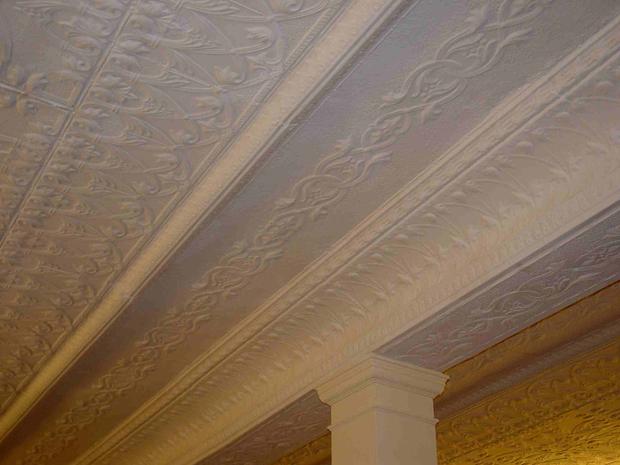Contact Bob
- 217.474.6052
- yapperman@msn.com
-
Belvedere School for Hands On Preservation
521 Bird Street, Hannibal MO 63401
Be sure to subscribe to my YouTube channel.
 Many years ago I was standing in a small library I had just completed. It had custom designed bookcases that flowed with the design of the 1882 house, birds eye maple floors, wainscoting, and just about every whoop-dee-doo you could imagine. By all rights it was a killer room, but something was missing. I looked up at the ceiling and realized that the expanse of gloss painted, drywall was about as exciting as Wayne Newton opening for an Eric Clapton concert. Something had to be done.
Many years ago I was standing in a small library I had just completed. It had custom designed bookcases that flowed with the design of the 1882 house, birds eye maple floors, wainscoting, and just about every whoop-dee-doo you could imagine. By all rights it was a killer room, but something was missing. I looked up at the ceiling and realized that the expanse of gloss painted, drywall was about as exciting as Wayne Newton opening for an Eric Clapton concert. Something had to be done.
I had lunch that day in a Thai restaurant and noticed, for the first time, the elaborate pressed tin ceiling. This was the perfect solution for my boring library ceiling. I headed back to my office and found three different ads in magazines for companies that still manufacture these gaudy ceiling blankets. Upon further research, I found that they’re the only three companies still manufacturing them today.
The oldest manufacturer is W.F. Norman Corporation in Nevada, Missouri. They celebrated their 100th anniversary in 1998. When I visited their facility it felt like I was walking into the Industrial Revolution of the 1800s. “Our company still makes the same patterns from the original dies and machinery W.F. Norman bought second hand in 1898,” co-owner Mark Quitno said proudly as we walked through the plant. Franklin Norman, the grandson of founder W.F. Norman, sold the business to the Quitno family in 1978.
I ordered my library ceiling right out of a reprint of an original 1898 W.F. Norman catalogue. I gave them my room dimensions and they sent me every piece I needed right down to the wood brackets that the cornice pieces attach to. The only things we had to buy were the required oil primer, oil paint and 22- 1″x 2″ wood firing strips and a box of bandages. The point about the bandages is simply—wear tight fitting leather gloves when you handle the tin panels. While the workers in the W.F. Norman plant throw this sharp edged metal around like Frisbees, none of them had a single cut on their hands. I on the other hand wanted to “feel” the metal and cut the heck out of myself. It took two of us about 8 hours to install everything on a ceiling 10’x 11′. That’s 110 square feet with a total material cost of about $500 or $4.55 a square foot. Most homeowners with average skills can tackle this project in a couple of weekends. If you hire the work done you can expect the price to double. Even so, that’s a pretty good price for a new ceiling that is truly a piece of art.
You can also try to salvage an old tin ceiling. Taking tin ceilings down is a huge, dirty and risky undertaking. Historic buildings usually have very tall ceilings and so rolling scaffolding is critical. I’ve always lost about 20% of the ceiling during the removal process due to rust and the degree of difficulty in prying the small nails loose from the wooden nailing strips under the panels. The years of old coal dust that has accumulated on top of the panels will make you look like you’re a coal miner coming home at the end of the day.
Once the ceiling is down they are usually covered with many layers of old lead paint and need to be stripped. So, you can see that it’s a lot of work and if you want to try and sell the pieces or the entire ceiling as a package, the labor & equipment needed to remove it will far exceed what you could sell it for.
One way to clean up tin ceilings in place is to walnut shell blast the paint off. This is sort of like sand blasting but instead of sand you use ground up walnut shells. These shells do not over heat the metal like sand, which tends to distort the designs and can cause buckling. It’s a huge mess to do it but if everything is out of the building, wear good protective clothing and practice safe lead techniques, it’s a fast and efficient way to clean up a ceiling in place.
Rust and old pipe holes can be repaired using architectural epoxies and the shaped to match the areas surrounding the patches. Once the paint is off you should re-paint it with oil-based primer and paint.
There will also be times when pieces are missing. As I said previously, W.F. Norman Company has been continuously manufacturing tin ceilings since 1898. They still use the same catalogue today they used then. I estimate they provided these ceilings for well over half of the buildings in Missouri.
Today, you can choose from a combination of almost 200 different designs from the three manufacturers. From simple patterns to high Victorian and Art Deco. Metal choices vary from tin coated steel to copper to brass and stainless steel. There’s bound to be something that works for your project.